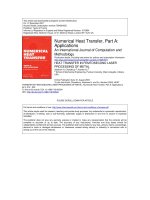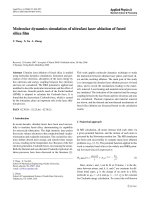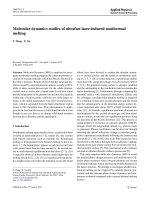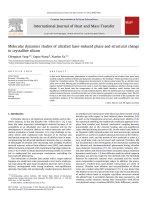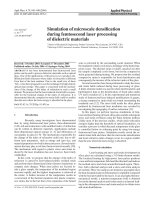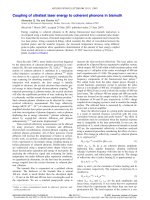heat transfer across metal dielectric interfaces during ultrafast laser heating
Bạn đang xem bản rút gọn của tài liệu. Xem và tải ngay bản đầy đủ của tài liệu tại đây (501.61 KB, 5 trang )
Liang Guo
Stephen L. Hodson
Timothy S. Fisher
Xianfan Xu
1
e-mail:
School of Mechanical Engineering
and Birck Nanotechnology Center,
Purdue University,
West Lafayette, IN 47907
Heat Transfer Across
Metal-Dielectric Interfaces
During Ultrafast-Laser Heating
Heat transfer across metal-dielectric interfaces involves transport of electrons and pho-
nons accomplished either by coupling between phonons in metal and dielectric or by cou-
pling between electrons in metal and phonons in dielectric. In this work, we investigate
heat transfer across metal-dielectric interfaces during ultrafast-laser heating of thin
metal films coated on dielectric substrates. By employing ultrafast-laser heating that cre-
ates strong thermal nonequilibrium between electrons and phonons in metal, it is possible
to isolate the effect of the direct electron–phonon coupling across the interface and thus
facilitate its study. Transient thermo-reflectance measurements using femtosecond laser
pulses are performed on Au–Si samples while the simulation results based on a two-
temperature model are compared with the measured data. A contact resistance between
electrons in Au and phonons in Si represents the coupling strength of the direct
electron–phonon interactions at the interface. Our results reveal that this contact resist-
ance can be sufficiently small to indicate strong direct coupling between electrons in
metal and phonons in dielectric. [DOI: 10.1115/1.4005255]
Keywords: interface thermal resistance, ultrafast laser, thermo-reflectance, two-temper-
ature model, electron–phonon coupling
1 Introduction
Interface heat transfer is one of the major concerns in the design
of microscale and nanoscale devices. In metal, electrons, and pho-
nons are both energy carriers while in dielectric phonons are the
main energy carrier. Therefore, for metal-dielectric composite
structures, heat can transfer across the interface by coupling
between phonons in metal and dielectric or by coupling between
electrons in metal and phonons in dielectric through electron-
interface scattering. Phonon–phonon coupling has been simulated
mainly by the acoustic mismatch model and the diffuse mismatch
model [1]. As for electron–phonon coupling, there are different
viewpoints. Some studies have assumed that electron–phonon
coupling across a metal-dielectric interface is negligible and heat
transfer occurs as electron–phonon coupling within metal and
then phonon–phonon coupling across the interface [2]. Electron–
phonon coupling between metal (Cr, Ti, Al, Ni, and Pt) and SiO
2
has exhibited negligible apparent thermal resistance using a
parallel-strip technique [3]. On the other hand, comparison
between simulations and transient thermal reflectance (TTR)
measurements for Au-dielectric interfaces reveals that energy
could be lost to the substrate by electron-interface scattering dur-
ing ultrafast-laser heating, and this effect depends on electron
temperature and substrate thermal properties [4–6].
In this study, we employ TTR techniques to investigate inter-
face heat transfer for thin gold films of varying thicknesses on sili-
con substrates. (Here, we consider silicon as a dielectric since heat
is carried by phonons in silicon.) Similar work has been reported
[5]. In our model, we consider two temperatures in metal and also
the temperature in the dielectric substrate. This allows us to inves-
tigate the effect of both the coupling between electrons in metal
and phonons in the dielectric substrate, and the coupling between
phonons in metal and phonons in the dielectric substrate, and
allows us to isolate the effect of the electron–phonon coupling
across the interface that can be determined from the TTR mea-
surement. Experimentally, we employ pulse stretching to mini-
mize the effect of nonequilibrium among the electrons. As a
result, the experimental data can be well-explained using the com-
putational model. The thermal resistance between electrons in Au
and phonons in Si, which quantifies the direct electron–phonon
coupling strength, is calculated from the measured data. The
results reveal that in the thermal nonequilibrium state, this
electron–phonon coupling at the interface is strong enough to
dominate the overall interface heat transfer.
2 TTR Measurement
Au–Si samples of varying Au thicknesses were prepared by
thermal evaporation at a pressure of the order of 10
À7
Torr. The
thicknesses of the gold films are 39, 46, 60, 77, and 250 nm, meas-
ured using an atomic force microscope. The pump-and-probe
technique is used in a collinear scheme to measure the thermo-
reflectance signal. The laser pulses are generated by a Spectra
Physics Ti:Sapphire amplified femtosecond system with a central
wavelength of 800 nm and a repetition rate of 5 kHz. The wave-
length of the pump beam is then converted to 400 nm with a sec-
ond harmonic crystal. The pump pulse has a pulse width (full
width at half maximum-FWHM) of 390 fs measured by the sum-
frequency cross-correlation method and is focused onto the sam-
ple with a spot radius of 20.3 lm. The probe beam has a central
wavelength of 800 nm and a pulse width of 205 fs measured by
autocorrelation and is focused with a spot radius of 16.9 lm. This
pump pulse width is intentionally stretched from the original pulse
width of 50 fs to minimize the influence of thermal nonequili-
brium among electrons since the electron thermalization time in
Au can be of the order of 100 fs [7]. This thermalization time is
pump wavelength and pump fluence dependent, and can be of the
order of 10 fs if higher laser fluence is used [8,9]. Our experiments
did show the importance of pulse stretching. Figure 1 shows the
TTR measurement results for the sample of thickness 77 nm with
different pump fluences before and after stretching the pulse. The
plots show the normalized relative reflectance change (ÀDR/R)
1
Corresponding author.
Contributed by the Heat Transfer Division of ASME for publication in the
J
OURNAL OF HEAT TRANSFER. Manuscript received May 18, 2011; final manuscript
received September 30, 2011; published online February 13, 2012. Assoc. Editor:
Robert D. Tzou.
Journal of Heat Transfer APRIL 2012, Vol. 134 / 042402-1Copyright
V
C
2012 by ASME
Downloaded 07 Mar 2012 to 128.211.160.45. Redistribution subject to ASME license or copyright; see />with the delay time between the pump and the probe pulses to
show the contrast in cooling rates. With a shorter pulse (Fig.
1(a)), a steep initial drop is seen in the signal, which is attributed
to the behavior of nonequilibrium among electrons. Since the
TTM to be used for simulation assumes a well-defined tempera-
ture for electrons, i.e., the electrons in gold have reached thermal
equilibrium (not necessarily a uniform temperature), the model
cannot predict the fast initial drop in the signals in Fig. 1(a).As
will be shown later, the signals obtained by stretching the pulse
can be predicted well using the TTM.
3 Two-Temperature Model for Thermal Reflectance
Measurements
Ultrafast-laser heating induces thermal nonequilibrium between
electrons and phonons in metal, which can be described by the
TTM [10–13]. We note that the heterogeneous interface consid-
ered here involves three primary temperature variables (two in the
metal and one in the dielectric). The “two-temperature” model is
applied to the metal side. For investigating electron–phonon and
phonon–phonon coupling at the interface, two thermal resistances
are defined: R
es
(its reciprocal) indicates the coupling strength
between electrons in metal and phonons in dielectric, while R
ps
indicates the coupling strength between phonons in metal and
phonons in dielectric. (Large thermal resistance corresponds to
weak coupling.) The resulting governing equations, initial, and
interface conditions are
C
e
@T
e
@t
¼ k
e
@
2
T
e
@x
2
À GðT
e
À T
p
ÞþS (1a)
C
p
@T
p
@t
¼ k
p
@
2
T
p
@x
2
þ GðT
e
À T
p
Þ (1b)
C
s
@T
s
@t
¼ k
s
@
2
T
s
@x
2
(1c)
T
e
ðt ¼ 0Þ¼T
p
ðt ¼ 0Þ¼T
s
ðt ¼ 0Þ¼T
0
(2)
Àk
e
@T
e
@x
x¼L
¼
T
e
À T
s
R
es
x¼L
(3a)
Àk
p
@T
p
@x
x¼L
¼
T
p
À T
s
R
ps
x¼L
(3b)
Àk
s
@T
s
@x
x¼L
¼
T
e
À T
s
R
es
x¼L
þ
T
p
À T
s
R
ps
x¼L
(3c)
The subscripts e, p, and s denote electrons in metal, phonons in
metal, and phonons in the dielectric substrate, respectively. C is
the volumetric heat capacity, k is the thermal conductivity, G is
the electron–phonon coupling factor governing the rate of energy
transfer from electrons to phonons in metal, and L is the thickness
of the metal layer. At the front surface of the metal layer insula-
tion boundary condition is used due to the much larger heat flux
caused by laser heating relative to the heat loss to air. At the rear
surface of the substrate, since the thickness of the substrate used is
large enough (1 lm) so that there is no temperature rise during the
time period of consideration, the insulation boundary condition is
also applied. Thermal properties of phonons in both metal and
dielectric are taken as temperature-independent due to the weak
temperature dependence. The thermal conductivity of phonons in
metal is much smaller than that of the electrons and is taken in
this work as 0.001 times the bulk thermal conductivity of gold
(311 W/(mK)). The volumetric heat capacity of the metal phonon
is taken as that of the bulk gold. C
e
is taken as proportional to T
e
[14] with the proportion coefficient being 70 J/(m
3
K
2
)[15], and k
e
is calculated by the model and the data used in Ref. [13] which is
valid from the room temperature to the Fermi temperature
(6.39 Â10
4
K in Au, [14]). G can be obtained using the model
derived in Ref. [16]. In this work, the value of G at the room tem-
perature is taken as 4.6 Â 10
16
W/(m
3
K) [17], and its dependence
on electron and phonon temperatures follows [16]. The laser heat-
ing source term S is represented by the model used in [13]as
S ¼
0:94ð1 À RÞJ
t
p
ðd þ d
b
Þ 1 À exp À
L
d þ d
b
exp À
x
d þ d
b
À 2:77
t
t
p
2
"#
(4)
which assumes all the absorbed laser energy is deposited in the
metal layer. J is the fluence of the pump laser, R is the surface re-
flectance to the pump, t
p
is the pulse width (FWHM), d is the opti-
cal penetration depth, and d
b
is the electron ballistic length
(around 100 nm in Au, [18]). R
es
and R
ps
are treated as free pa-
rameters for fitting the experimental data.
The wavelength of the probe laser in the experiment is centered
at 800 nm. For this wavelength, the incident photon energy is
below the interband transition threshold in Au, which is around
2.47 eV [18], and the Drude model can be used to relate the tem-
peratures of electrons and phonons to the dielectric function and
then the index of refraction, which is expressed as [19]
e ¼ e
1
À
x
2
p
xðx þ ix
s
Þ
(5)
x is the frequency of the probe laser and x
p
is the plasma fre-
quency (1.37 Â 10
16
rad/s in Au evaluated using the data in Ref.
[14]). x
s
is the electron collisional frequency, the inverse of the
electron relaxation time. The temperature dependence of electrical
Fig. 1 TTR measurement results for the Au–Si sample of Au
thickness 77 nm with different fluences. (a) Results before
pulse stretching; (b) results after pulse stretching.
042402-2 / Vol. 134, APRIL 2012 Transactions of the ASME
Downloaded 07 Mar 2012 to 128.211.160.45. Redistribution subject to ASME license or copyright; see />resistivity indicates that x
s
is approximately proportional to pho-
non temperature at high temperature [14] and from the Fermi liq-
uid theory, its variation with electron temperature is quadratic
(T
e
2
)[20]. Therefore, x
s
is related to T
e
and T
p
approximately as
x
s
¼ A
ee
T
2
e
þ B
ep
T
p
(6)
A
ee
is estimated from the low-temperature measurement [21]and
B
ep
is usually estimated from the thermal or electrical resistivity
near the room temperature [14]. In this work, A
ee
is taken as the lit-
erature value 1.2 Â 10
7
s
À1
K
À2
[6] while e
1
and B
ep
are evaluated
by fitting the room-temperature value of the complex dielectric con-
stant at 800 nm wavelength provided in Ref. [22], which are found
to be 9.7 and 3.6 Â 10
11
s
À1
K
À1
, respectively. The complex index
of refraction n
0
þ in
00
is the square root of the dielectric constant.
Using Eqs. (5) and (6), n
0
and n
00
are evaluated as 0.16 and 4.90,
respectively, which agree with the empirical values [23]. The re-
flectance is then calculated from n
0
and n
00
by the method of transfer
matrix [24], which considers multiple reflections in thin films.
4 Results and Discu ssion
The results of TTR measurements with a pump fluence of
147 J/m
2
are plotted in Fig. 2. The fast decrease of the reflectance
indicates that energy transfer between electrons and phonons in
metal, followed by a relatively slow decrease after several ps
which indicates electrons and phonons have reached thermal equi-
librium. The initial cooling rates are smaller for samples with
thicknesses less than the electron ballistic length since the electron
temperature is almost uniform across the thin film, and coupling
with phonons within the metal film and the dielectric substrate is
the only cooling mechanism. For a thicker sample of thickness
250 nm, the initial decrease is much faster due to thermal diffu-
sion in the gold film caused by a gradient of the electron tempera-
ture in the film.
We investigate the effect of R
es
and R
ps
using the thermo-
reflectance signal. Two values of R
ps
,1Â 10
À10
m
2
K/W and
1 Â 10
À7
m
2
K/W, are used, each with a parameterized range of
values for R
es
. Figure 3 shows the calculated results for the sample
with a 39 nm-thick gold film.
Little difference can be seen between Figs. 3(a) and 3(b) while
different cooling rates are obtained with varying R
es
in either plot,
indicating that the cooling rate is not sensitive to the coupling
strength between phonons in metal and dielectric. Note that an
interface resistance of 1 Â 10
À10
m
2
K/W is lower than any
reported value, indicating a very high coupling strength between
the phonons in metal and dielectric. Conversely, the results vary
greatly with the coupling strength between electrons in metal and
phonons in dielectric at the interface. This is because the lattice
(phonon) temperature rise in metal is much smaller than the elec-
tron temperature that the interface coupling between phonons in
metal and dielectric does not influence the surface temperature,
which directly determines the measured reflectance. On the other
hand, the temperature rise of electrons is much higher, and conse-
quently, the cooling rate is sensitive to R
es
. The relatively high
sensitivity of R
es
to that of R
ps
demonstrates that the former can
be isolated for the study of the coupling between electrons in
metal and phonons in dielectric.
We now use the measured TTR data to estimate R
es
, the thermal
resistance between electrons in metal and phonons in dielectric.
R
es
is adjusted by the least square method to fit the simulation
results with the measured data, and the results are shown in Fig. 4.
We note that it is impossible to fit the measured results using insu-
lation interface condition (i.e., no coupling or extremely large
thermal resistance between electrons in metal and phonons in the
dielectric substrate), which will significantly underestimate the
cooling rate. For thin samples, we find that the value of R
es
is of
the order of 10
À10
to 10
À9
m
2
K/W. This value is below the ther-
mal resistances of representative solid–solid interfaces measured
in thermal equilibrium [25]. This indicates that the direct coupling
between electrons in metal and phonons in dielectric is strong. It
is also noted that the resistance values increases with the thickness
of the gold film, indicating a decrease in the coupling strength
between electrons in metal and the dielectric substrate. This could
be due to the lower electron temperature obtained in thicker films,
and a decrease of the coupling strength with a decrease in the
electron temperature [5]. For the sample of thickness 250 nm, R
es
has little effect on the simulation result since the interface is too
far from the absorbing surface to influence the surface tempera-
ture, and therefore it is not presented here.
The agreement between the fitted results and the measured data
is generally good. The small discrepancy between the measured
and the fitted results can result from inaccuracy in computing the
Fig. 2 TTR measurement results on Au–Si samples of varying
Au thicknesses
Fig. 3 Simulation results with varying R
es
for the Au–Si sample
of Au thickness 39 nm. (a) R
ps
5 1 3 10
210
m
2
K/W; (b) R
ps
5 1310
27
m
2
K/W.
Journal of Heat Transfer APRIL 2012, Vol. 134 / 042402-3
Downloaded 07 Mar 2012 to 128.211.160.45. Redistribution subject to ASME license or copyright; see />absorption or the temperature. Figure 1(b) shows the normalized
TTR measurement results on the sample of thickness 77 nm with
three laser fluences. It is seen that small variations in the shape of
the TTR signals can be caused by different laser fluences and thus
the maximum temperature reached in the film. Absorption in metal,
multiple reflections between the metal surface and the Au–Si inter-
face, and possible deviations of the properties of thin films from
those of bulk can all contribute to uncertainties in the temperature
simulation; therefore affecting the calculated reflectance.
With the values of R
es
shown in Fig. 4, the calculation shows
that the highest electron temperature, which is at the surface of 39
nm–thick gold film, is about 6700 K. The highest temperature of
electrons is roughly inversely proportional to the thickness of the
films for the four thinner films. The highest temperature of elec-
trons is much less than the Fermi temperature and thus ensures the
validity of the linear dependence of C
e
on T
e
[14]. The highest
temperature for the lattice in metal is about 780 K, also in the 39
nm-thick gold film. This large temperature difference between
electrons and lattice indicates that the interface heat transfer is
dominated by the coupling between electrons in metal and the
phonons in the dielectric substrate. As shown in Fig. 4, the meas-
ured R
es
is very low, of the order of 10
À10
to 10
À9
m
2
K/W. Even
if R
ps
, which is not determined in this study, is also that low (note
that 10
À10
to 10
À9
m
2
K/W is lower than any reported values),
because of the large difference in temperatures between electrons
and the phonons in metal, the interface heat transfer rate (Eqs.
(3a)–(3c)) due to the coupling between electrons in metal and the
substrate is much larger than that due to the coupling between
phonons in metal and the substrate.
5 Conclusions
In conclusion, TTR measurements using femtosecond laser
pulses are performed on Au–Si samples and the results are
analyzed using the TTM model. It is shown that due to the strong
nonequilibrium between electrons and phonons during ultrafast-
laser heating, it is possible to isolate the effect of the direct
electron–phonon coupling across the interface, allowing investiga-
tion of its strength. Using stretched femtosecond pulses is shown
to be able to minimize the nonequilibrium effect among electrons,
and is thus more suitable for this study. The TTR measurement
data can be well-represented using the TTM model. Comparison
between the TTR data and the TTM results indicates that the
direct coupling due to electron-interface scattering dominates the
interface heat transfer during ultrafast-laser heating of thin films.
Acknowledgment
This paper is based upon work supported by the Defense
Advanced Research Projects Agency and SPAWAR Systems Cen-
ter, Pacific under Contract No. N66001-09-C-2013. The authors
also thank C. Liebig, Y. Wang, and W. Wu for helpful
discussions.
Nomenclature
A
ee
¼ coefficient in Eq. (6), s
À1
K
À2
B
ep
¼ coefficient in Eq. (6), s
À1
K
À1
C ¼ volumetric heat capacity, J/(m
3
K)
G ¼ electron–phonon coupling factor, W/(m
3
K)
i ¼ unit of the imaginary number
J ¼ fluence of the pump, J/m
2
k ¼ thermal conductivity, W/(mK)
L ¼ metal film thickness, m
n
0
¼ real part of the complex index of refraction
n
00
¼ imaginary part of the complex index of refraction
R ¼ interface thermal resistance, m
2
K/W; reflectance
S ¼ laser source term, W/m
3
Fig. 4 Comparison between the measurement and the simulation results for
Au–Si samples of different Au thicknesses. The open circle represents the meas-
ured data and the solid line represents the simulation results. (a) 39 nm fitted by
R
es
5 5 3 10
210
m
2
K/W; (b) 46 nm fitted by R
es
5 6 3 10
210
m
2
K/W; (c) 60 nm fitted
by R
es
5 1.2 3 10
29
m
2
K/W; and (d) 77 nm fitted by R
es
5 1.8 3 10
29
m
2
K/W.
042402-4 / Vol. 134, APRIL 2012 Transactions of the ASME
Downloaded 07 Mar 2012 to 128.211.160.45. Redistribution subject to ASME license or copyright; see />T ¼ temperature, K
t ¼ time, s
t
p
¼ pulse width of the pump (FWHM), s
x ¼ spatial coordinate, m
e ¼ complex dielectric constant
e
1
¼ constant in the Drude model
d ¼ radiation penetration depth, m
d
b
¼ electron ballistic depth, m
x ¼ angular frequency of the probe, rad/s
x
p
¼ plasma frequency, rad/s
x
s
¼ electron collisional frequency, rad/s
Subscripts
0 ¼ initial state
e ¼ electron in metal
es ¼ electron in metal and phonon in dielectric
p ¼ phonon in metal
ps ¼ phonon in metal and phonon in dielectric
s ¼ phonon in dielectric
References
[1] Cahill, D. G., Ford, W. K., Goodson, K. E., Mahan, G. D., Majumdar, A.,
Maris, H. J., Merlin, R., and Phillpot, S. R., 2003, “Nanoscale Thermal Trans-
port,” J. Appl. Phys., 93(2), pp. 793–818.
[2] Majumdar, A., and Reddy, P., 2004, “Role of Electron–Phonon Coupling in
Thermal Conductance of Metal–Nonmetal Interfaces,” Appl. Phys. Lett.,
84(23), pp. 4768–4770.
[3] Chien, H C., Yao, D J., and Hsu, C T., 2008, “Measurement and Evaluation
of the Interfacial Thermal Resistance Between a Metal and a Dielectric,” Appl.
Phys. Lett., 93(23), p. 231910.
[4] Hopkins, P. E., and Norris, P. M., 2007, “Substrate Influence in Electron–
Phonon Coupling Measurements in Thin Au Films,” Appl. Surf. Sci., 253(15),
pp. 6289–6294.
[5] Hopkins, P. E., Kassebaum, J. L., and Norris, P. M., 2009, “Effects of Electron
Scattering at Metal–Nonmetal Interfaces on Electron-Phonon Equilibration in
Gold Films,” J. Appl. Phys., 105(2), p. 023710.
[6] Hopkins, P. E., 2010, “Influence of Electron-Boundary Scattering on Thermore-
flectance Calculations After Intraband and Interband Transitions Induced by
Short-Pulsed Laser Absorption,” Phys. Rev. B, 81(3), p. 035413.
[7] Sun, C K., Vallee, F., Acioli, L., Ippen, E. P., and Fujimoto, J. G., 1993,
“Femtosecond Investigation of Electron Thermalization in Gold,” Phys. Rev. B,
48(16), pp. 12365–12368.
[8] Fann, W. S., Storz, R., Tom, H. W. K., and Bokor, J., 1992, “Electron Thermal-
ization of Gold,” Phys. Rev. B, 46(20), pp. 13592–13595.
[9] Fann, W. S., Storz, R., Tom, H. W. K., and Bokor, J., 1992, “Direct Measure-
ment of Nonequilibrium Electron-Energy Distributions in Subpicosecond
Laser-Heated Gold Films,” Phys. Rev. Lett., 68(18), pp. 2834–2837.
[10] Kaganov, M. I., Lifshitz, I. M., and Tanatarov, L. V., 1957, “Relaxation
Between Electrons and the Crystalline Lattice,” Sov. Phys. JETP, 4(2), pp.
173–178.
[11] Anisimov. S. I., Kapeliovich, B. L., and Perel’man, T. L., 1974, “Electron
Emission From Metal Surfaces Exposed to Ultrashort Laser Pulses,” Sov. Phys.
JETP, 39(2), pp. 375–377.
[12] Qiu, T. Q., and Tien, C. L., 1993, “Heat Transfer Mechanisms During Short-
Pulse Laser Heating of Metals,” ASME Trans. J. Heat Transfer, 115(4), pp.
835–841.
[13] Chowdhury, I. H., and Xu, X., 2003, “Heat Transfer in Femtosecond Laser
Processing of Metal,” Numer. Heat Transfer, Part A, 44(3), pp. 219–232.
[14] Kittel, C., 1976, Introduction to Solid State Physics, John Wiley & Sons, Inc.,
New York.
[15] Smith, A. N., and Norris, P. M., 2001, “Influence of Intraband Transitions on
the Electron Thermoreflectance Response of Metals,” Appl. Phys. Lett., 78(9),
pp. 1240–1242.
[16] Chen, J. K., Latham, W. P., and Beraun, J. E., 2005, “The Role of Electron–
Phonon Coupling in Ultrafast Laser Heating,” J. Laser Appl., 17(1), pp. 63–68.
[17] Hostetler, J. L., Smith, A. N., Czajkowsky, D. M., and Norris, P. M., 1999,
“Measurement of the Electron-Phonon Coupling Factor Dependence on Film
Thickness and Grain Size in Au, Cr, and Al,” Applied Optics, 38(16), pp.
3614–3620.
[18] Hohlfeld, J., Wellershoff, S S., Gudde, J., Conrad, U., Jahnke, V., and Mat-
thias, E., 2000, “Electron and Lattice Dynamics Following Optical Excitation
of Metals,” Chem. Phys., 251(1–3), pp. 237–258.
[19] Maier, S. A., 2007, Plasmonics: Fundamentals and Applications, Springer
Science þ Business Media, New York.
[20] Ashcroft, N. W., and Mermin, N. D., (1976), Solid State Physics, W. B. Saun-
ders, Philadelphia.
[21] MacDonald, A. H., 1980, “Electron-Phonon Enhancement of Electron-Electron
Scattering in Al,” Phys. Rev. Lett., 44(7), pp. 489–493.
[22] Johnson, P. B., and Christy, R. W., 1972, “Optical Constants of the Noble Met-
als,” Phys. Rev. B, 6(12), pp. 4370–4379.
[23] Palik, E. D., (1998), Handbook of Optical Constants of Solids, Academic, San
Diego.
[24] Pedrotti, F. L., Pedrotti, L. S., and Pedrotti, L. M., (2007), Introduction to
Optics, Pearson Prentice Hall, Upper Saddle River, NJ.
[25] Incropera, F. P., Dewitt, D. P., Bergman, T. L., and Lavine, A. S., 2007, Funda-
mentals of Heat and Mass Transfer, John Wiley & Sons, Inc., Hoboken, NJ.
Journal of Heat Transfer APRIL 2012, Vol. 134 / 042402-5
Downloaded 07 Mar 2012 to 128.211.160.45. Redistribution subject to ASME license or copyright; see />



